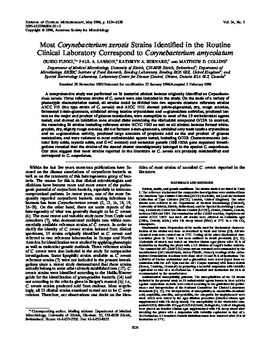| dc.contributor.author | Lawson, Paul A. | |
| dc.contributor.author | Bernard, Kathryn A. | |
| dc.contributor.author | Collins, Matthew D. | |
| dc.contributor.author | Funke, Guido | |
| dc.date.accessioned | 2015-06-01T16:35:07Z | |
| dc.date.accessioned | 2016-03-30T15:34:19Z | |
| dc.date.available | 2015-06-01T16:35:07Z | |
| dc.date.available | 2016-03-30T15:34:19Z | |
| dc.date.issued | 1996-05 | |
| dc.identifier.citation | Funke, Guido, et al. Most Corynebacterium xerosis Strains Identified in the Routine Clinical Laboratory Correspond to Corynebacterium amycolatum. Journal of Clinical Microbiology, V. 34, No. 5 (May 1996): 1124-1128. | en_US |
| dc.identifier.uri | https://hdl.handle.net/11244/14653 | |
| dc.description.abstract | A comprehensive study was performed on 25 bacterial clinical isolates originally identified as Corynebacterium xerosis. Three reference strains of C. xerosis were also included in the study. On the basis of a variety of phenotypic characteristics tested, all strains could be divided into two separate clusters: reference strains ATCC 373 (the type strain of C. xerosis) and ATCC 7711 showed yellow-pigmented, dry, rough colonies, fermented 5-keto-gluconate, exhibited strong leucine arylamidase and alpha-glucosidase activities, produced lactate as the major end product of glucose metabolism, were susceptible to most of the 19 antimicrobial agents tested, and showed an inhibition zone around disks containing the vibriocidal compound O/129. In contrast, the remaining 26 strains including reference strain NCTC 7243 as well as all clinical isolates formed white-grayish, dry, slightly rough colonies, did not ferment 5-keto-gluconate, exhibited only weak leucine arylamidase and no alpha-glucosidase activity, produced large amounts of propionic acid as the end product of glucose metabolism, and were resistant to most antimicrobial agents tested, including O/129. Chemotaxonomic (cellular fatty acids, mycolic acids, and G+C content) and molecular genetic (16S rRNA gene sequence) investigations revealed that the strains of the second cluster unambiguously belonged to the species C. amycolatum. Our data suggest that most strains reported in the literature as C. xerosis are probably misidentified and correspond to C. amycolatum. | en_US |
| dc.description.sponsorship | This study was supported by the European Community( CT93-0119 and CT94-3098), the Jubilaumsspende der Universitat Zurich, and the Hochschulverein Zurich. G.F. acknowledges support by a grant from the Sassella-Stiftung (Zurich, Switzerland). | en_US |
| dc.language | en_US | en_US |
| dc.relation.uri | http://jcm.asm.org/content/34/5/1124.abstract | |
| dc.subject | bacterial clinical isolates; Corynebacterium xerosis; antimicrobial agents; Corynebacterium amycolatum | en_US |
| dc.title | Most Corynebacterium xerosis Strains Identified in the Routine Clinical Laboratory Correspond to Corynebacterium amycolatum | en_US |
| dc.type | Article | en_US |
| dc.description.peerreview | Yes | en_US |
| ou.group | College of Arts and Sciences::Department of Microbiology and Plant Biology | en_US |
